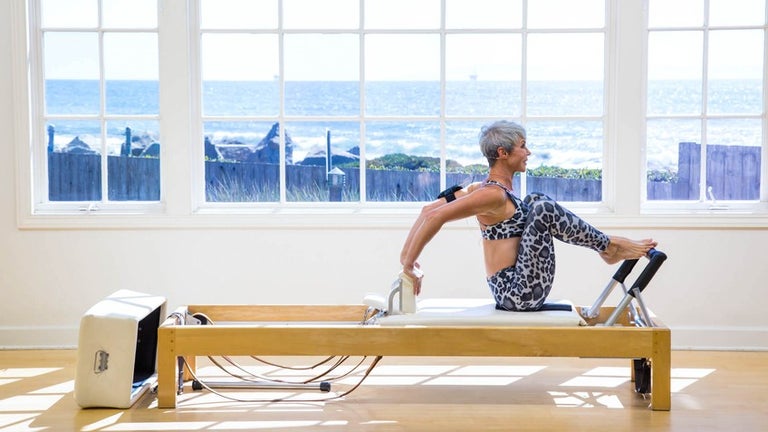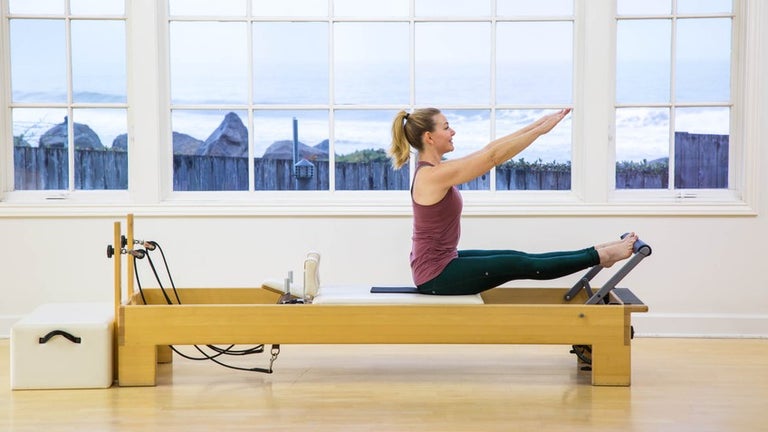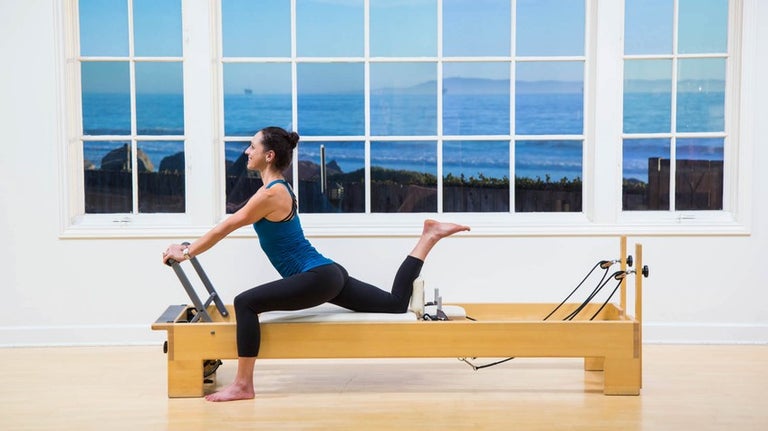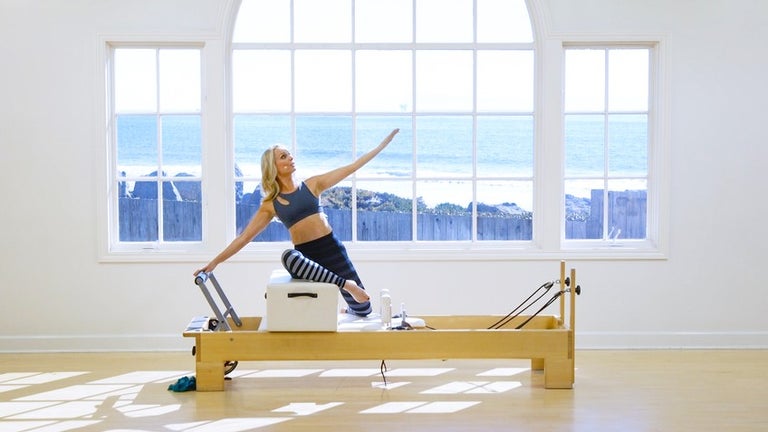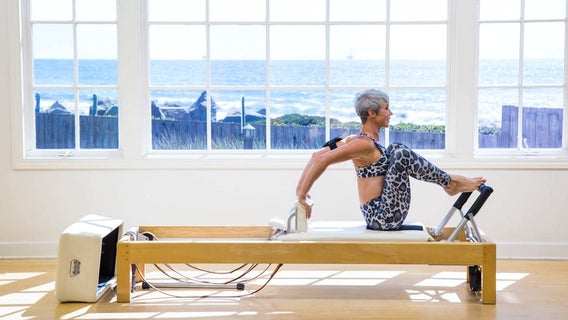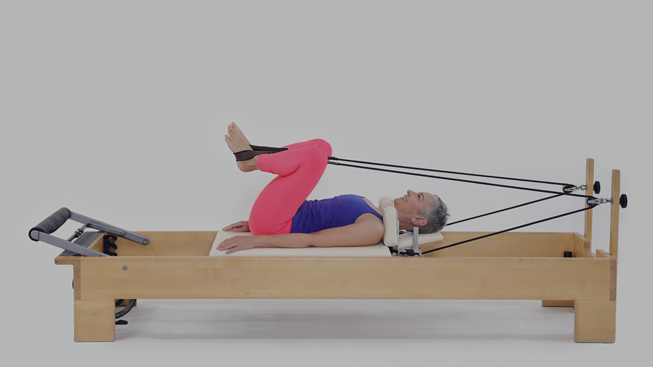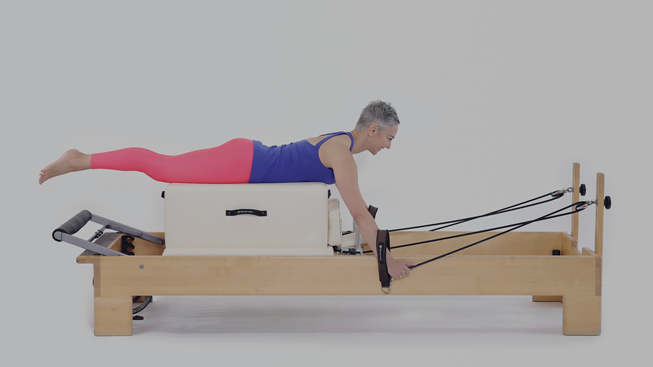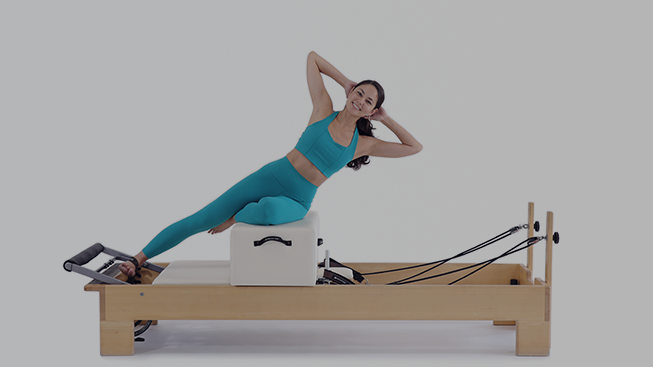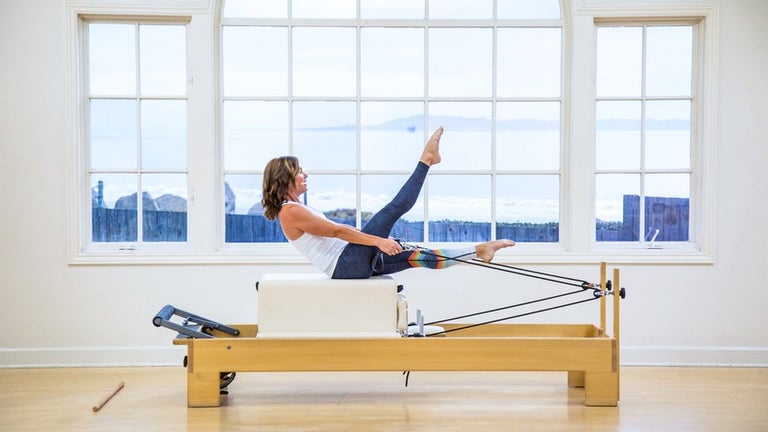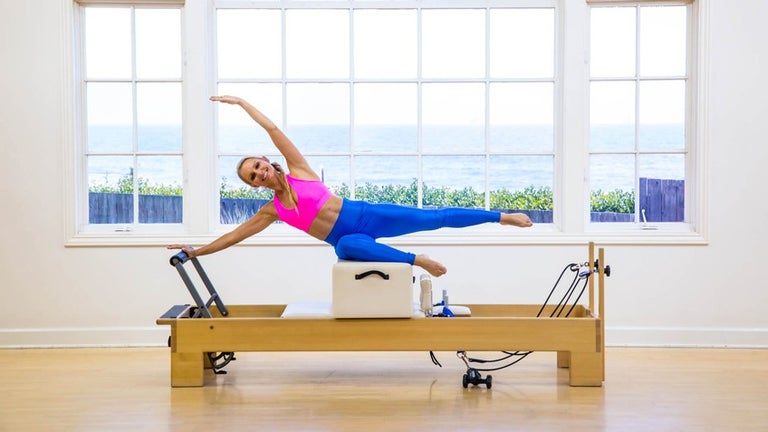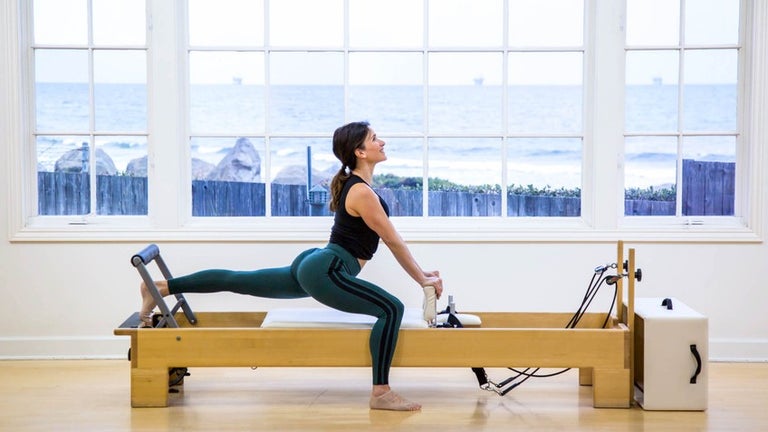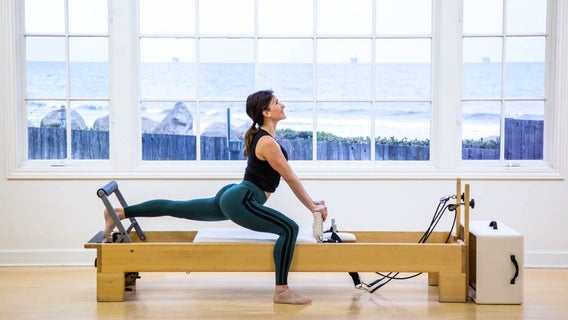Reformer Pilates for Beginners
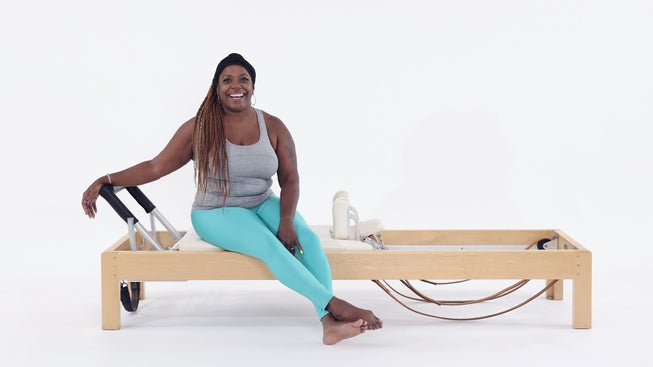
Benefits of Reformer Pilates for Beginners
While a Pilates Reformer may appear strange at first, with its springs, straps, and other moveable parts, it is actually an ideal apparatus, or “Pilates machine”, for beginning your Pilates practice. That’s because when you lie down on the Reformer with your shoulders resting against the two block shoulder pads at the top of the apparatus and your feet resting against the Footbar, your Pilates instructor can spot imbalances in your body right away before you even start to move. Is one hip higher than the other? Is one shoulder higher? This information will help your instructor give you the right mix of exercises to bring you back into ideal alignment.
How to Get Started
While you may begin your Reformer practice online, we recommend you first work with an instructor due to the complexity of the apparatus and safety. Look for a studio that offers private sessions or learn from ainstructor on Zoom if in-person teaching is not an option. You can also start in a group Reformer class, but bear in mind that some Pilates studios will require students to take a few private sessions before joining a group class.
Before your first lesson, your Pilates instructor will likely ask you a series of questions about your health and fitness goals, your exercise and movement background, and whether you are dealing with current or chronic injuries or health concerns.Based on your responses, your instructor will devise an appropriate and effective Pilates program for you.
It is common for people to tend to move too fast when they are first starting Pilates. Moving at a slower, deliberate pace is essential in understanding each exercise and improving your form. As you advance in your practice, you will gradually get into a flow. Stay aware of your breath and if something hurts or is uncomfortable, make sure to communicate that with your instructor. Because the Pilates Method is a system, not just a series of unrelated exercises, expect to see the same shapes of the spine and body movements that recur in different formats. As you become more experienced, you will see how various exercises intersect, complement, and build upon each other. That’s part of the fun.
Tips and Precautions
Before you begin working out on the Reformer, we recommend following safety precautions and best practices. Be aware that the platform will move differently depending upon how many springs are attaching the carriage to the frame. Fewer springs mean less resistance, while more springs mean more resistance. Always check that there are at least one or two springs attached before stepping onto the Reformer.
If you are attending a class at a studio, we suggest wearing special “grip socks” with silicone grips on the sole. These socks will help keep the Reformer clean and also prevent you from slipping or sliding during your workout. Shoes are not worn on the Reformer, as they may damage the upholstery. Furthermore, Pilates exercises make use of the foot’s ability to articulate, which is not possible wearing shoes.
Take a moment to make sure that the floor around your Reformer is clear of props, towels, or anything else that you or your instructor could trip on. Check that the Footbar is properly resting in its slot before you put your full weight on it in exercises like Long Stretch. Make sure that your clothing or jewelry isn’t loose or dangling where it could get caught in the Reformer’s springs. Following best practices and safety guidelines will help prevent accidents and injuries.
Beginner Reformer Classes

Reformer Pilates Exercises for Beginners
As a Beginner, you will work on exercises in which you are connected to the Reformer in several places, as well as exercises with minimal spinal shapes. We recommend sticking to exercises that work the limbs in unison, rather than one limb at a time, as this provides stability and makes the exercises easier to learn at first. It is unlikely that you will be performing exercises that require a lot of balance, such as Side Splits or Lunges.
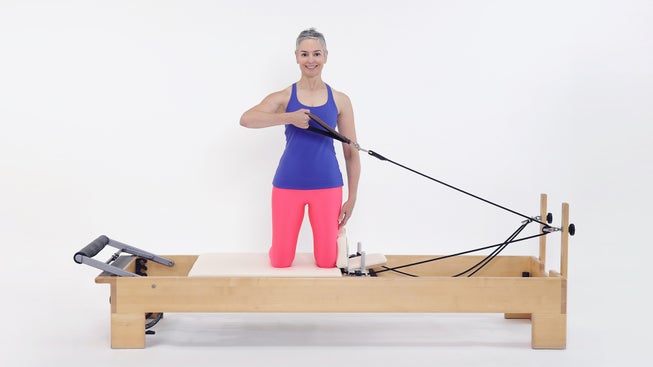
Most beginners start out with simple exercises like Footwork. This series serves as a warm-up and allows you to get comfortable with the moving platform while remaining supported by the carriage. From there, you will progress to more challenging exercises, such as the Hundred, Knee Stretches, and Running. These exercises can be more challenging in terms of choreography, level of strength, or body awareness required. In some of these exercises, you may be lying on your back or kneeling on the Reformer or on the Box that rests atop the Reformer.
Beginner Exercises
Mermaid
Mermaid
This exercise strengthens and stretches the obliques and shoulders.
Frog
Frog
This exercise focus on strengthening the abdominals, inner thighs and back of the legs while opening up the hips and stabilizing the pelvis.
Intermediate Exercises
Pulling Straps
Pulling Straps
This intermediate exercise strengthens the shoulders, arms and upperback.
Side Situps
Side Situps
This exercise challenges and strengthens the outer thigh, obliques and proprioception.
Progressions
You will probably begin with a short Reformer set, but over time, your instructor will add more exercises and more challenging versions of the exercises already in your repertoire. If you are able to perform the basic series while maintaining good form and using the desired muscle groups (not overloading the legs in Footwork, for example, but working the entire body in this exercise), you are likely ready to level up your Reformer practice.
At this point, you can add exercises that involve spinal rotation (twisting) and lateral flexion (side bending), such as the Short Box series, Stomach Massage, and Mermaid. You may also be ready for exercises that involve a bit more “choreography” or a sequence of movements, such as Coordination or Up Stretch. Additionally, you can add one-sided exercises like Tree on the Short Box, as well as exercises that challenge your balance such as Lunges.
Since Pilates exercises are subtle, you may not “get it” after your first class. Trust the work and you will progressively get more out of the exercises after each session. In Classical Pilates, a set order of exercises are performed each workout with slight variations. Pilates exercises are designed to build upon one another and challenge different areas of the body, such as the upper body and the lower body, so that no muscle group is overtrained.
Advanced Practice
If you have been on Instagram lately, you have probably seen an abundance of creative and very challenging exercises. While some of these exercises are products of the creator’s imagination, there are plenty of traditional Pilates exercises for expert practitioners. These exercises include the Long Spine Stretch, the full Lunge series, the Arm series, and the Long Box, as well as other movements in which the hips leave the carriage. Your Pilates teacher will start to introduce more advanced exercises to your repertoire so that you may continue to progress in your practice. We recommend you explore advanced exercises under the watchful eye of an experienced Pilates instructor, who can serve as a spotter and offer tactile (hands-on) cueing as you begin.
An advanced Reformer practice moves at an accelerated pace, with one exercise flowing into the next one. While you will be responsible for executing the repertoire correctly and have a good understanding of the “how” and the “why” of each exercise, an advanced practice also includes memorizing the order of the exercises and seamlessly setting up the Reformer for each exercise (Footbar placement, spring settings, etc.). The result is a workout that almost resembles a dance between practitioner and apparatus.
How do you know when to progress safely to this level? Advanced Pilates exercises require tremendous strength, flexibility, body awareness, confidence, and familiarity with the equipment. If you work one-on-one with an instructor, they will add new exercises into your workout one at a time, when your skills allow. Over time, and it may take several years, your Reformer workout will expand in duration as well as an increase in difficulty.
Intermediate Reformer Classes
Your Pilates Anytime Membership Benefits
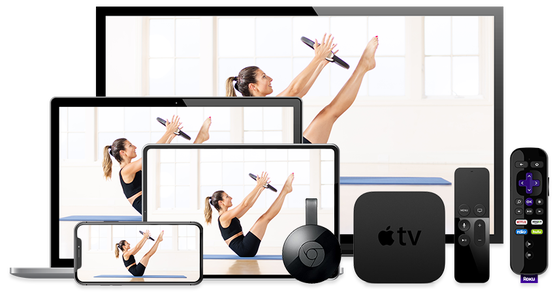
- 15-Day Free Trial
- Unlimited Access to Thousands of Classes
- 95+ Pilates Programs and Challenges
- No Ads
- New Videos Weekly
- Available on All Your Favorite Devices
